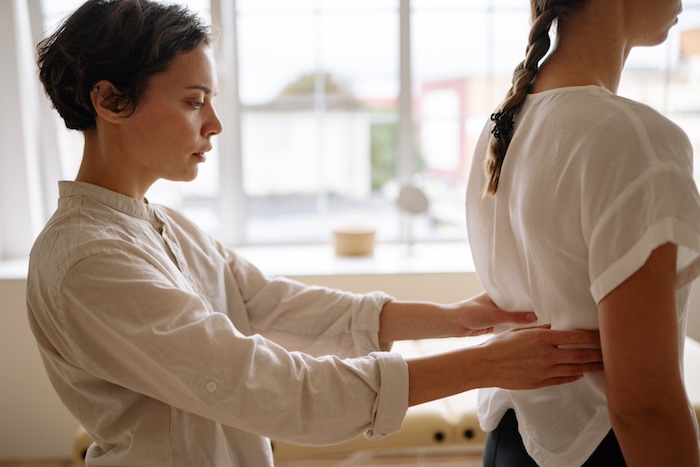
Physical therapy and exercise for lower back pain generate meaningful results when performed at a slow and steady pace. Continuing the therapeutic exercises at this pace helps the body get accustomed to improved posture and overall wellness—preventing further injury.
Guidelines to Start a Lower Back Exercise Program
The following set of guidelines can help achieve the desirable short- and long-term results of physical therapy, stay consistent with the program, and reduce exercise-related aches and pains.
1. Hydrate And Energize
Exercise burns calories and releases energy from the cells of the body. About 30 minutes before starting a set of exercises, eating a healthy snack and drinking enough water can help stay energized and hydrated. It is important to refrain from caffeine or alcohol for several hours before starting an exercise.
2. Find A Comfortable Place To Practice
A routine exercise program requires access to a peaceful, calm room with enough area to be able to lie down and stretch in different directions. A yoga or exercise mat and breathable clothing can help stay relaxed and comfortable throughout the exercise session(s). Yoga blocks, a small rolled-up towel, and knee pads can help provide additional support for the lower back and knees while performing exercises that require kneeling or lying down.
3. Apply Heat To The Lower Back
Heat therapy before exercise enhances blood flow and flexibility, reducing stiffness in the lower back.
Applying heat to the lower back before starting an exercise can be beneficial in several ways. Heat therapy increases the temperature of tissues, causing blood vessels to dilate. Dilation of blood vessels improves blood flow, oxygen, and healing nutrients to the lower back, decreasing stiffness and increasing flexibility in the spinal muscles. The overall range of motion of the lower back improves, making it easier and less painful to start the exercises.
Application of heat is typically recommended for 20 minutes to achieve its intended therapeutic benefit.
4. Activate The Muscle Fibers With Repetitions
The desired result (stretching/strengthening) of an exercise on the muscle tissue depends on the number of repetitions of the exercise. Repetition or rep is the number of times an exercise is performed before a short break is taken. A set is a group of repetitions, for example, 2 sets of 10 reps. A break or pause is given between each set.
During a rep, muscle fibers are lengthened and shortened cyclically, slowly allowing them to stretch out, contract, and eventually build strength.
5. Start Slow
It is advisable to begin a lower back exercise program with easy, low-impact exercises and start with fewer reps per set, gradually increasing the number of reps. During the initial period, vibration or shaking may be experienced in the leg or thigh muscles. This shaking indicates that the muscle is weak or unaccustomed to the specific movement. The vibration or shaking usually goes away with time when the muscle builds strength and endurance through periodic exercise.
Initial soreness may result due to the tissue changes associated with exercise and can be managed with cold therapy or over-the-counter medications. If severe pain is felt at any point during or after an exercise, it is advisable to consult a physician or physical therapist.
How A Physical Therapist Can Help With Back Exercise
Physical therapists have special training in assessing the lower back, hip, and legs to determine the overall spinal strength, health of the supporting muscles, and flexibility of the back. Based on the findings from their assessment and other diagnostic test results, physical therapists create an exercise program that can be tolerated by the patient to gradually improve their symptoms and signs.
A physical therapist may also help provide additional hands-on therapies, as needed, through the course of the program to help reduce pain and enhance healing. These hands-on therapies may include but are not limited to:
- Massage therapy
- Manual therapy
- Myofascial release
- Spinal manipulation
Working with a physical therapist can improve the compliance and dedication of patients at the beginning of the program, ultimately leading to improved treatment outcomes and long-term commitment.
Physical therapy for back pain usually requires a maintenance program—where patients continue to practice their exercises at home for several months (or longer) to keep their lower back conditioned and prevent the recurrence of pain. Maintenance therapy is crucial in stabilizing the back and maintaining a balanced and supported posture. Incorporating a set (or two) of exercises into the daily routine can go a long way in providing a general feeling of well-being and preventing the pain from returning.
Precision Pain Care and Rehabilitation has two convenient locations in Richmond Hill – Queens, and New Hyde Park – Long Island. Call the Queens office at (718) 215-1888 or (516) 419-4480 for the Long Island office to arrange an appointment with our Interventional Pain Management Specialists, Dr. Jeffrey Chacko or Dr. Sonny Ahluwalia.













